Reconsidering the Empirical Measurement of Trust towards Unknown Others
Abstract
:1. Introduction
2. Trust towards Unknown Others and Relatedness to Others’ Otherness
3. Data and Methods
Generally speaking, would you say that most people can be trusted, or that you can’t be too careful in dealing with people? Please tell me on a score of 0 to 10, where 0 means you can’t be too careful and 10 means that most people can be trusted.
To what extent do you think [respondent’s country] should allow people from the poorer countries outside Europe to come and live here? (The responses: 1: Allow many to come and live here; 2: Allow some; 3: Allow a few; 4: Al-low none)
Please say to what extent you agree or disagree with each of the following statements: Gay men and lesbians should be free to live their own life as they wish. (The responses: 1: Agree strongly; 2: Agree; 3: Neither agree nor disagree; 4: Disagree; 5: Disagree strongly)
4. The Empirical Relationship between Trust and Relatedness to Others’ Otherness
4.1. The Macro-Perspective
4.2. The Micro Perspective
5. Discussion and Conclusions
Author Contributions
Funding
Institutional Review Board Statement
Informed Consent Statement
Conflicts of Interest
Appendix A
| Country | Mean | Standard Deviation | Skewness | Kurtosis | N (Unweighted) |
|---|---|---|---|---|---|
| AT | 5.30 | 2.48 | −0.50 | −0.35 | 3769 |
| BE | 5.16 | 2.10 | −0.26 | −0.41 | 1580 |
| BG | 3.68 | 2.49 | −0.43 | 0.34 | 3289 |
| CH | 6.07 | 1.99 | 0.09 | −0.60 | 2572 |
| CY | 3.85 | 2.33 | −0.57 | 0.15 | 526 |
| CZ | 5.15 | 2.41 | −0.54 | −0.40 | 4095 |
| DE | 4.82 | 2.59 | −0.67 | −0.17 | 9085 |
| DK | 7.02 | 1.83 | 0.61 | −0.85 | 1372 |
| EE | 5.71 | 2.10 | 0.19 | −0.54 | 2940 |
| ES | 4.80 | 2.58 | −0.55 | −0.26 | 3182 |
| FI | 6.90 | 1.80 | 1.27 | −1.08 | 2980 |
| FR | 4.67 | 2.07 | −0.14 | −0.36 | 3298 |
| GB | 5.26 | 2.21 | −0.19 | −0.50 | 1812 |
| GR | 4.51 | 1.95 | −0.31 | 0.12 | 2310 |
| HR | 4.44 | 2.53 | −0.49 | −0.07 | 2760 |
| HU | 4.92 | 2.39 | −0.61 | −0.29 | 2665 |
| IE | 5.52 | 2.28 | −0.36 | −0.48 | 1778 |
| IS | 6.54 | 2.01 | 1.04 | −0.96 | 1521 |
| IT | 4.97 | 2.22 | −0.33 | −0.39 | 3604 |
| LT | 4.93 | 2.50 | −0.52 | −0.18 | 2261 |
| LV | 4.51 | 2.54 | −0.55 | −0.26 | 541 |
| ME | 3.93 | 2.61 | −0.56 | 0.16 | 1508 |
| MK | 3.73 | 2.75 | −0.84 | 0.23 | 792 |
| NL | 6.33 | 1.78 | 0.81 | −0.94 | 2740 |
| NO | 6.72 | 1.91 | 0.35 | −0.74 | 2499 |
| PL | 3.37 | 2.75 | −0.78 | 0.40 | 2825 |
| PT | 4.01 | 2.41 | −0.68 | 0.01 | 2177 |
| RS | 3.68 | 2.85 | −0.77 | 0.28 | 2277 |
| SE | 5.80 | 2.47 | −0.34 | −0.57 | 3398 |
| SI | 4.70 | 2.49 | −0.64 | −0.22 | 1970 |
| SK | 4.04 | 2.60 | −0.73 | 0.20 | 2002 |
| Country | Age | Gender | Education | Political Alignment | Trust in Legal System | Life Satisfaction | People Coming from Non-European. Poorer Countries | Gays and Lesbians Free to Live as They Wish | |||||
|---|---|---|---|---|---|---|---|---|---|---|---|---|---|
| Male | Female | Low | Medium | High | Allow None | Allow at Least a Few | Does Not Agree | Agree | |||||
| AT | 49.21 (17.36) | 49.5 | 50.5 | 16.7 | 56.7 | 26.6 | 4.57 (2.05) | 6.49 (2.48) | 7.74 (2.00) | 13.8 | 86.2 | 15.7 | 84.3 |
| BE | 48.00 (17.70) | 49.7 | 50.3 | 25.9 | 37.4 | 36.7 | 4.96 (1.99) | 5.33 (2.28) | 7.48 (1.67) | 7.9 | 92.1 | 11.0 | 89.0 |
| BG | 51.04 (17.33) | 49.5 | 50.5 | 18.4 | 54.9 | 26.7 | 5.60 (2.43) | 2.98 (2.48) | 5.85 (2.39) | 31.1 | 68.9 | 56.0 | 44.0 |
| CH | 48.29 (17.70) | 50.2 | 49.8 | 15.9 | 59.3 | 24.8 | 5.06 (2.04) | 6.90 (1.98) | 8.22 (1.58) | 4.6 | 95.4 | 12.2 | 87.8 |
| CY | 47.85 (16.82) | 51.6 | 48.4 | 22.8 | 45.3 | 31.9 | 5.44 (2.57) | 4.48 (2.49) | 7.09 (2.01) | 16.3 | 83.7 | 46.1 | 53.9 |
| CZ | 48.81 (17.71) | 49.5 | 50.5 | 11.0 | 69.9 | 19.1 | 5.64 (2.08) | 5.45 (2.57) | 7.10 (1.82) | 39.5 | 60.5 | 39.3 | 60.7 |
| DE | 49.43 (18.05) | 50.7 | 49.3 | 14.9 | 64.6 | 20.5 | 4.39 (2.05) | 6.06 (2.55) | 7.13 (2.29) | 5.7 | 94.3 | 10.3 | 89.7 |
| DK | 48.46 (17.62) | 50.5 | 49.5 | 22.2 | 50.2 | 27.6 | 5.04 (2.30) | 7.56 (2.02) | 8.45 (1.53) | 8.8 | 91.2 | 8.7 | 91.3 |
| EE | 48.63 (16.82) | 46.8 | 53.2 | 11.4 | 52.5 | 36.1 | 5.45 (1.89) | 6.17 (2.42) | 7.26 (1.87) | 21.0 | 79.0 | 38.8 | 61.2 |
| ES | 48.48 (18.40) | 49.5 | 50.5 | 43.0 | 26.7 | 30.2 | 4.17 (2.67) | 4.52 (2.82) | 6.93 (2.26) | 4.5 | 95.5 | 9.5 | 90.5 |
| FI | 50.22 (17.78) | 49.0 | 51.0 | 18.5 | 51.0 | 30.5 | 5.59 (2.19) | 7.29 (2.02) | 8.06 (1.51) | 6.5 | 93.5 | 15.1 | 84.9 |
| FR | 49.16 (17.35) | 48.2 | 51.8 | 22.9 | 54.9 | 22.2 | 4.93 (2.24) | 5.22 (2.46) | 6.73 (2.23) | 10.8 | 89.2 | 10.1 | 89.9 |
| GB | 47.70 (16.65) | 51.4 | 48.6 | 22.7 | 43.7 | 33.6 | 4.83 (1.91) | 5.84 (2.43) | 7.29 (2.05) | 8.5 | 91.5 | 11.2 | 88.8 |
| GR | 49.57 (17.77) | 50.4 | 49.6 | 30.8 | 42.5 | 26.7 | 5.23 (1.92) | 6.50 (2.24) | 6.37 (1.72) | 31.1 | 68.9 | 29.2 | 70.8 |
| HR | 49.15 (17.54) | 48.6 | 51.4 | 21.2 | 62.3 | 16.5 | 4.99 (2.55) | 2.74 (2.36) | 7.17 (2.33) | 10.6 | 89.4 | 43.7 | 56.3 |
| HU | 49.50 (17.16) | 48.0 | 52.0 | 18.6 | 60.6 | 20.7 | 5.64 (2.50) | 5.64 (2.45) | 6.54 (2.18) | 46.7 | 53.3 | 57.4 | 42.6 |
| IE | 46.98 (17.27) | 50.0 | 50.0 | 21.6 | 47.0 | 31.4 | 4.93 (1.81) | 5.30 (2.46) | 7.20 (1.91) | 7.7 | 92.3 | 7.7 | 92.3 |
| IS | 45.29 (16.85) | 52.6 | 47.4 | 25.7 | 41.3 | 33.0 | 4.92 (2.23) | 6.03 (2.19) | 8.03 (1.63) | 1.5 | 98.5 | 2.8 | 97.2 |
| IT | 50.52 (17.50) | 49.5 | 50.5 | 42.3 | 42.5 | 15.3 | 5.18 (2.35) | 5.36 (2.33) | 6.97 (1.93) | 12.2 | 87.8 | 23.9 | 76.1 |
| LT | 49.30 (15.02) | 45.8 | 54.2 | 9.6 | 59.0 | 31.4 | 5.15 (2.46) | 5.00 (2.50) | 6.63 (2.24) | 14.5 | 85.5 | 62.8 | 37.2 |
| LV | 48.88 (14.49) | 49.2 | 50.8 | 10.9 | 61.4 | 27.7 | 5.85 (2.15) | 4.66 (2.63) | 6.81 (2.09) | 28.9 | 71.1 | 39.7 | 60.3 |
| ME | 45.51 (15.02) | 52.6 | 47.4 | 17.6 | 53.8 | 28.7 | 4.07 (3.07) | 4.41 (2.90) | 7.19 (2.15) | 18.8 | 81.2 | 66.6 | 33.4 |
| MK | 43.99 (14.49) | 55.5 | 44.5 | 17.8 | 59.0 | 23.2 | 5.45 (2.87) | 2.96 (2.70) | 6.28 (2.55) | 39.9 | 60.1 | 75.8 | 24.2 |
| NL | 48.31 (17.87) | 50.4 | 49.6 | 27.0 | 42.8 | 30.2 | 5.16 (2.01) | 6.62 (1.94) | 7.89 (1.39) | 8.5 | 91.5 | 4.1 | 95.9 |
| NO | 47.96 (17.63) | 51.0 | 49.0 | 15.7 | 48.7 | 35.6 | 5.01 (2.40) | 7.47 (1.92) | 7.87 (1.67) | 1.6 | 98.4 | 5.8 | 94.2 |
| PL | 48.87 (17.86) | 49.8 | 50.2 | 29.6 | 40.6 | 29.9 | 5.59 (2.75) | 3.65 (2.50) | 6.60 (2.31) | 9.4 | 90.6 | 38.7 | 61.3 |
| PT | 49.77 (17.29) | 47.6 | 52.4 | 49.6 | 27.2 | 23.2 | 4.93 (2.16) | 4.15 (2.48) | 6.88 (2.09) | 4.8 | 95.2 | 13.8 | 86.2 |
| RS | 46.80 (16.35) | 49.1 | 50.9 | 14.6 | 61.3 | 24.1 | 4.58 (2.67) | 3.68 (2.96) | 5.79 (2.74) | 17.6 | 82.4 | 57.6 | 42.4 |
| SE | 46.94 (17.94) | 51.6 | 48.4 | 16.3 | 51.7 | 32.0 | 5.16 (2.50) | 6.07 (2.45) | 7.54 (1.87) | 4.2 | 95.8 | 7.0 | 93.0 |
| SI | 49.85 (17.32) | 50.9 | 49.1 | 13.6 | 61.4 | 25.1 | 4.85 (2.40) | 4.23 (2.48) | 7.51 (1.90) | 11.3 | 88.7 | 26.6 | 73.4 |
| SK | 47.61 (17.21) | 49.4 | 50.6 | 11.1 | 66.5 | 22.4 | 5.18 (2.50) | 4.23 (2.75) | 6.40 (2.18) | 30.9 | 69.1 | 52.7 | 47.3 |
| 1 | For more information see: http://www.europeansocialsurvey.org/ (accessed on 20 July 2023). |
| 2 | In the ESS, highest level of completed education is measured according to ISCED (International Standard Classification of Education) categories. We collapsed the variable to reflect those with low (at most completed primary education), medium (any type of secondary but not tertiary education) or high (at least a BA diploma) educational attainment. |
| 3 | In politics people sometimes talk of “left” and “right”. Using this card, where would you place yourself on this scale, where 0 means the left and 10 means the right? |
| 4 | Using this card, please tell me on a score of 0–10 how much you personally trust each of the institutions I read out. 0 means you do not trust an institution at all, and 10 means you have complete trust. How much do you trust the legal system? |
| 5 | All things considered, how satisfied are you with your life as a whole nowadays? Please answer using this card, where 0 means extremely dissatisfied and 10 means extremely satisfied. |
References
- Alesina, Alberto, and Eliana La Ferrara. 2002. Who Trusts Others? Journal of Public Economics 85: 207–34. [Google Scholar] [CrossRef]
- Algan, Yann, and Pierre Cahuc. 2010. Inherited Trust and Growth. American Economic Review 100: 2060–92. [Google Scholar] [CrossRef]
- Algan, Yann, and Pierre Cahuc. 2013. Trust, Growth and Well-Being: New Evidence and Policy Implications. Discussion Paper No. 7464. Bonn: IZA. [Google Scholar]
- Ali, Amjad, Ali Sabz, Ahmad Khan Sajjad, Muhamed Khan Dost, Abbas Kamran, Khalil Alamgir, Manzoor Sadaf, and Khalil Umair. 2019. Sample Size Issues in Multilevel Logistic Regression Models. PLoS ONE 14: e0225427. [Google Scholar] [CrossRef] [PubMed]
- Almond, Gabriell, and Sidney Verba. 1963. The Civic Culture. Political Attitudes and Democracy in Five Nations. Princeton: Princeton University Press. [Google Scholar]
- Alsop, Ruth, Mette Bertelsen, and Jeremy Holland. 2006. Empowerment in practice: From analysis to implementation. In Directions in Development. Washington: World Bank. [Google Scholar] [CrossRef]
- André, Stéfanie. 2013. Does trust mean the same for migrants and natives? Testing measurement models of political trust with multi-group confirmatory factor analysis. Social Indicators Research 115: 963–82. [Google Scholar] [CrossRef]
- Bachmann, Reinhard. 2011. At the Crossroads: Future Directions in Trust Research. Journal of Trust Research 1: 203–13. [Google Scholar] [CrossRef]
- Bachmann, Reinhard, and Akbar Zaheer. 2006. Handbook of Trust Research. Northampton: Edward Elgar Publishing Limited. [Google Scholar]
- Baier, Anette. 1995. Moral Prejudices: Essays on Ethics. Cambridge: Harvard University Press. [Google Scholar]
- Barber, Bernard. 1983. The Logic and Limits of Trust. New Brunswick: Rutgers University Press. [Google Scholar]
- Bauer, Paul, and Marcus Freitag. 2018. Measuring Trust. In Oxford Handbook of Social and Political Trust. Edited by Eric Uslaner. Oxford: Oxford University Press, pp. 15–36. [Google Scholar]
- Bauer, Paul C. 2021. Clearing the Jungle: Conceptualising Trust and Trustworthiness. In Trust Matters: Cross-Disciplinary Essays. Edited by Raquel Barradas de Freitas and Sergio Lo Iacono. London: Bloomsbury Academic, pp. 17–34. [Google Scholar]
- Bergh, Andreas, and Christian Bjørnskov. 2011. Historical Trust Levels Predict the Current Size of the Welfare State. Kyklos 64: 1–19. [Google Scholar] [CrossRef]
- Bergh, Andreas, and Christian Bjørnskov. 2014. Trust, Welfare States and Income Inequality: Sorting out the Causality. European Journal of Political Economy 35: 183–99. [Google Scholar] [CrossRef]
- Bernát, Anikó, and Bori Simonovits. 2016. The Social Aspects of the 2015 Migration Crisis in Hungary. Budapest: TÁRKI Social Research. [Google Scholar]
- Bjørnskov, Christian. 2007. Determinants of Generalized Trust: A Cross-country Comparison. Public Choice 130: 1–21. [Google Scholar] [CrossRef]
- Bodor, Ákos, Zoltán Grünhut, and Réka Horeczki. 2018. Considering the Linkage between the Theory of Trust and Classical Rural Sociology’s Concepts. European Countryside 10: 482–97. [Google Scholar] [CrossRef]
- Bodor, Ákos, Zoltán Grünhut, and Viktor Varjú. 2020. The Effect of Trust on the Various Dimensions of Climate Change Atti-tudes. Sustainability 12: 10200. [Google Scholar] [CrossRef]
- Brehm, John, and Wendy Rahn. 1997. Individual-level Evidence for the Causes and Consequences of Social Capital. American Journal of Political Science 41: 999–1023. [Google Scholar] [CrossRef]
- Bryan, Mark, and Jenkins Stephen. 2016. Multilevel Modelling of Country Effects: A Cautionary Tale. European Sociological Review 32: 3–22. [Google Scholar] [CrossRef]
- Coleman, James. 1990. Foundations of Social Theory. Cambridge: Harvard University Press. [Google Scholar]
- Cook, Karen. 2001. Trust in Society. New York: Russell Sage Foundation. [Google Scholar]
- Cook, Karen, and Jessica Santana. 2018. Trust and Rational Choice. In Oxford Handbook of Social and Political Trust. Edited by Eric Uslaner. Oxford: Oxford University Press, pp. 253–78. [Google Scholar]
- Costa, Dora, and Matthew Kahn. 2003. Civic engagement and community heterogeneity: An economist’s perspective. Perspectives on Politics 1: 103–11. [Google Scholar] [CrossRef]
- Daniele, Gianmarco, and Benny Geys. 2015. Interpersonal Trust and Welfare State Support. European Journal of Political Economy 39: 1–12. [Google Scholar] [CrossRef]
- Davidov, Eldad. 2009. Measurement equivalence of nationalism and constructive patriotism in the ISSP: 34 countries in a comparative perspective. Political Analysis 17: 64–82. [Google Scholar] [CrossRef]
- Delhey, Jan, and Kenneth Newton. 2005. Predicting Cross-national Levels of Social Trust: Global Pattern or Nordic Exceptionalism? European Sociological Review 21: 311–27. [Google Scholar] [CrossRef]
- Delhey, Jan, Kenneth Newton, and Christian Welzel. 2011. How General Is Trust in “Most People”? Solving the Radius of Trust Problem. American Sociological Review 76: 786–806. [Google Scholar] [CrossRef]
- Dietz, Graham. 2011. Going Back to the Source: Why Do People Trust Each Other? Journal of Trust Research 1: 215–22. [Google Scholar] [CrossRef]
- Dinesen, Peter. 2013. Where You Come from or Where You Live? Examining the Cultural and Institutional Explanation of Generalized Trust Using Migration as a Natural Experiment. European Sociological Review 29: 114–28. [Google Scholar] [CrossRef]
- Dinesen, Peter, and Mannemar Sønderskov. 2015. Ethnic Diversity and Social Trust: Evidence from the Micro-Context. American Sociological Review 80: 550–73. [Google Scholar] [CrossRef]
- Dinesen, Peter, Merlin Schaeffer, and Mannemar Sønderskov. 2020. Ethnic diversity and social trust: A narrative and meta-analytical review. Annual Review of Political Science 23: 441–65. [Google Scholar] [CrossRef]
- ESS. 2018. European Social Survey (ESS) Round 8. Available online: https://www.europeansocialsurvey.org/data?round=21 (accessed on 20 July 2023).
- ESS. 2020. European Social Survey (ESS) Round 9. Available online: https://www.europeansocialsurvey.org/data?round=16 (accessed on 20 July 2023).
- ESS. 2022. European Social Survey (ESS) Round 10. Available online: https://www.europeansocialsurvey.org/data?round=15 (accessed on 20 July 2023).
- Frederiksen, Morten. 2018. On the inside of generalized trust: Trust disposition as perceptions of self and others. Current Sociology 67: 1–24. [Google Scholar] [CrossRef]
- Freitag, Marcus, and Marc Bühlmann. 2009. Crafting Trust: The Role of Political Institutions in a Comparative Perspective. Comparative Political Studies 42: 1537–66. [Google Scholar] [CrossRef]
- Freitag, Marcus, and Paul Bauer. 2013. Testing for measurement equivalence in surveys: Dimensions of social trust across cultural contexts. Public Opinion Quarterly 77: 24–44. [Google Scholar] [CrossRef]
- Freitag, Marcus, and Richard Traunmüller. 2009. Spheres of trust: An empirical analysis of the foundations of particularised and generalised trust. European Journal of Political Research 48: 782–803. [Google Scholar] [CrossRef]
- Fukuyama, Francis. 1995. Trust: The Social Virtues and the Creation of Prosperity. New York: Free Press. [Google Scholar]
- Füzér, Katalin. 2016. The Social Theory of Trust and the Sociological Theory of Social Capital. Belvedere Meridionale 28: 132–39. [Google Scholar] [CrossRef]
- Füzér, Katalin, Ákos Huszár, Ákos Bodor, Lajos Bálint, and Attila Pirmajer. 2020. Social capitals, social class, and prosperity in high-trust and low-trust societies. International Journal of Sociology 50: 48–67. [Google Scholar] [CrossRef]
- Gambetta, Diego, ed. 1988. Trust: Making and Breaking Cooperative Relations. Oxford: Basil Blackwell. [Google Scholar]
- Giddens, Anthony. 1990. The Consequences of Modernity. Cambridge: Polity Press. [Google Scholar]
- Glaeser, Edward, David Laibson, Jose Scheinkman, and Christine Soutter. 2000. Measuring Trust. The Quarterly Journal of Economics 115: 811–46. [Google Scholar] [CrossRef]
- Glanville, Jennifer, Matthew Andersson, and Pamela Paxton. 2013. Do Social Connections Create Trust? An Examination Using New Longitudinal Data. Social Forces 92: 545–62. [Google Scholar] [CrossRef]
- Gundelach, Britte, and Richard Traunmüller. 2013. Beyond generalised trust: Norms of reciprocity as an alternative form of social capital in an assimilationist integration regime. Political Studies 62: 596–617. [Google Scholar] [CrossRef]
- Hardin, Russel. 2002. Trust and Trustworthiness. New York: Russell Sage Foundation. [Google Scholar]
- Hardin, Russel. 2006. Trust. Key Concepts Series. London: Polity. [Google Scholar]
- Helliwell, John, and Robert Putnam. 2004. The Social Context of Well-Being. Philosophical Transactions of the Royal Society of London 359: 1435–46. [Google Scholar] [CrossRef] [PubMed]
- Helliwell, John, and Shun Wang. 2010. Trust and Well-Being. NBER Working Papers. No. 15911. Cambridge: National Bureau of Economic Research. [Google Scholar]
- Helliwell, John, Haifang Huang, and Shun Wang. 2016. The Distribution of World Happiness. World Happiness Report 2016. New York: Sustainable Development Solutions Network. [Google Scholar]
- Herreros, Francisco. 2004. The Problems of Forming Social Capital. Why Trust? New York: Palgrave. [Google Scholar]
- Hooghe, Marc, Tim Reeskens, Dietlind Stolle, and Ann Trappers. 2009. Ethnic Diversity and Generalized Trust in Europe. Comparative Political Studies 42: 198–223. [Google Scholar] [CrossRef]
- Hosmer, David, Stanley Lemeshow, and Rodney Sturdivant. 2013. Applied Logistic Regression. Hoboken: John Wiley & Sons. [Google Scholar] [CrossRef]
- Inglehart, Ronald, and Pippa Norris. 2003. Rising Tide: Gender Equality and Cultural Change around the World. Cambridge: Cambridge University Press. [Google Scholar]
- Knack, Stephen, and Philip Keefer. 1997. Does social capital have an economic payoff? A cross-country investigation. The Quarterly Journal of Economics 112: 1251–88. [Google Scholar] [CrossRef]
- Kumlin, Staffan, and Bo Rothstein. 2005. Making and Breaking Social Capital: The Impact of Welfare-state Institutions. Comparative Political Studies 38: 339–65. [Google Scholar] [CrossRef]
- Kumove, Michael. 2020. Diversity, semi-communication and cross-country trust: A quantitative analysis. Social Science Research 86: 102392. [Google Scholar] [CrossRef] [PubMed]
- Kumove, Michael. 2023. Rent-Free in Your Head? How Generalised Trust is Affected by the Trust and Salience of Outgroups. Social Indicators Research 166: 575–600. [Google Scholar] [CrossRef]
- Leigh, Andrew. 2006. Trust, Inequality and Ethnic Heterogeneity. The Economic Record 82: 268–80. [Google Scholar] [CrossRef]
- Li, Wai, and Daniel Liang. 2002. Particularized Trust and Generalized Trust: The Structure and Nature of Chinese People’s. Sociological Research 2: 11–22. [Google Scholar]
- Luhmann, Niklas. 1979. Trust and Power. New York: Wiley Publishing. [Google Scholar]
- Lundmark, Sebastian, Mikael Gilljam, and Stefan Dahlberg. 2015. Measuring generalized trust: An examination of question wording and the number of scale points. Public Opinion Quarterly 80: 26–43. [Google Scholar] [CrossRef]
- Lyon, Fergus, Guido Möllering, and Mark Saunders. 2012. Handbook of Research Methods on Trust. Cheltenham: Edward Elgar. [Google Scholar]
- Messing, Vera, and Bence Ságvári. 2021. Are anti-immigrant attitudes the Holy Grail of populists? A comparative analysis of attitudes towards immigrants, values, and political populism in Europe. Intersections East European Journal of Society and Politics 7: 100–27. [Google Scholar] [CrossRef]
- Mewes, Jan. 2014. Gen(d)eralized Trust: Women, Work, and Trust in Strangers. European Sociological Review 30: 373–86. [Google Scholar] [CrossRef]
- Miller, Alan, and Tomoko Mitamura. 2003. Are surveys on trust trustworthy? Social Psychology Quarterly 66: 62–70. [Google Scholar] [CrossRef]
- Möllering, Guido. 2006. Trust: Reason, Routine, Reflexivity. Amsterdam: Elsevier. [Google Scholar]
- Mood, Carina. 2010. Logistic Regression: Why We Cannot Do What We Think We Can Do, and What We Can Do About It. European Sociological Review 26: 67–82. [Google Scholar] [CrossRef]
- Naef, Michael, and Jürgen Schupp. 2009. Measuring trust: Experiments and surveys in contrast and combination. IZA Discussion Paper 4087: 1–44. [Google Scholar] [CrossRef]
- Nannestad, Peter. 2008. What Have We Learned About Generalized Trust, If Anything? Annual Review of Political Science 11: 413–36. [Google Scholar] [CrossRef]
- Newton, Ken. 2001. Trust, Social Capital, Civil Society, and Democracy. International Political Science Review 22: 201–14. [Google Scholar] [CrossRef]
- Nooteboom, Bart. 2006. Social Trust, Institutions and Trust. CentER Working Paper No. 2006-35. Tilburg: Tilburg University. [Google Scholar]
- Norris, Pippa. 1999. Critical Citizens: Global Support for Democratic Government. Oxford: Oxford University Press. [Google Scholar] [CrossRef]
- OECD. 2011. The Well-Being of Nations. Paris: OECD Publishing. [Google Scholar]
- Paxton, Pamela. 1999. Is Social Capital Declining in the United States? A Multiple Indicator Assessment. American Journal of Sociology 105: 88–127. [Google Scholar] [CrossRef]
- Paxton, Pamela. 2007. Association Memberships and Generalized Trust: A Multilevel Model across 31 Countries. Social Forces 86: 47–76. [Google Scholar] [CrossRef]
- Poznyak, Dimitry, Bart Meuleman, Koen Abts, and George Bishop. 2014. Trust in American government: Longitudinal measurement equivalence in the ANES. 1964–2008. Social Indicators Research 118: 741–58. [Google Scholar] [CrossRef]
- Putnam, Robert. 2000. Bowling Alone: The Collapse and Revival of American Community. New York: Free Press. [Google Scholar]
- Putnam, Robert. 2007. E Pluribus Unum: Diversity and community in the twenty-first century. Scandinavian Political Studies 30: 137–74. [Google Scholar] [CrossRef]
- Reeskens, Tim. 2013. But Who are Those ‘Most People’ That Can be Trusted? Evaluating the Radius of Trust Across 29 European Societies. Social Indicators Research 114: 703–22. [Google Scholar] [CrossRef]
- Reeskens, Tim, and Marc Hooghe. 2008. Cross-cultural measurement equivalence of generalized trust. Evidence from the European Social Survey 2002 and 2004. Social Indicators Research 85: 515–32. [Google Scholar] [CrossRef]
- Robbins, Blaine. 2022. Measuring Generalized Trust: Two New Approaches. Sociological Methods and Research 51: 305–56. [Google Scholar] [CrossRef]
- Rothstein, Bo, and Dietlind Stolle. 2002. How political institutions create and destroy social capital: An institutional theory of generalized trust. Paper presented at the 98th Meeting of the American Political Science Association, Boston, MA, USA, August 29–September 1. [Google Scholar]
- Rothstein, Bo, and Eric Uslaner. 2005. All for All: Equality, Corruption, and Social Trust. World Politics 58: 41–72. [Google Scholar] [CrossRef]
- Rotter, Julian. 1967. A new scale for the measurement of interpersonal trust. Journal of Personality 35: 651–65. [Google Scholar] [CrossRef] [PubMed]
- Seligman, Adam. 1997. The Problem of Trust. Princeton: Princeton University Press. [Google Scholar]
- Seymour, Jeffrey, Michael Welch, Karen Gregg, and Jessica Collett. 2014. Generating Trust in Congregations: Engagement, Exchange, and Social Networks. Journal for the Scientific Study of Religion 53: 130–44. [Google Scholar] [CrossRef]
- Simpson, Brenett. 2006. The Poverty of Trust in the Southern United States. Social Forces 84: 1625–38. [Google Scholar] [CrossRef]
- Snijders, Tom, and Roel Bosker. 1999. Multilevel Analysis: An Introduction to Basic and Advanced Multilevel Modeling. Thousand Oaks: Sage Publications. [Google Scholar]
- Stolle, Dietlind, Stuart Soroka, and Richard Johnston. 2008. When does diversity erode trust? Neighbourhood diversity, interpersonal trust and the mediating effect of social interactions. Political Studies 56: 57–75. [Google Scholar] [CrossRef]
- Sturgis, Patrick, and Patten Smith. 2010. Assessing the validity of generalized trust questions: What kind of trust are we measuring? International Journal of Public Opinion Research 22: 74–92. [Google Scholar] [CrossRef]
- Sztompka, Piotr. 1999. Trust: A Sociological Theory. Cambridge: Cambridge University Press. [Google Scholar]
- Tabellini, Guido. 2010. Culture and Institutions: Economic Development in the Regions of Europe. Journal of the European Economic Association 8: 677–716. [Google Scholar] [CrossRef]
- Takács, Judit, and Ivett Szalma. 2019. Social Attitudes towards Homosexuality in Hungary and Romania. Does the Main Religious Denomination Matter? Intersections East European Journal of Society and Politics 5: 71–99. [Google Scholar] [CrossRef]
- Tamilina, Larysa. 2018. A Brief Overview of Approaches to Defining Social Trust. MPRA Paper Archive No. 96510. Munich: Munich Personal RePEc Archive. [Google Scholar]
- Tam, Kim-Pong, and Hoi-Wing Chan. 2018. Generalized trust narrows the gap between environmental concern and proenvironmental behavior: Multilevel evidence. Global Environmental Change 48: 182–94. [Google Scholar] [CrossRef]
- Torpe, Lars, and Henrik Lolle. 2011. Identifying Social Trust in Cross-Country Analysis: Do We Really Measure the Same? Social Indicators Research 103: 481–500. [Google Scholar] [CrossRef]
- Uslaner, Eric. 2002. The Moral Foundations of Trust. Cambridge: Cambridge University Press. [Google Scholar]
- Uslaner, Eric. 2010. Segregation, mistrust and minorities. Ethnicities 10: 415–34. [Google Scholar] [CrossRef]
- Uslaner, Eric. 2012. Measuring Generalized Trust: In Defense of the ‘Standard’ Question. In Handbook of Research Methods on Trust. Edited by Fergus Lyon, Guido Möllering and Mark Saunders. Cheltenham: Edward Elgar, pp. 97–106. [Google Scholar]
- Uslaner, Eric. 2018. Social and Political Trust. Oxford: Oxford University Press. [Google Scholar]
- Van der Veld, William, and Willem Saris. 2011. Causes of generalized social trust: An innovative crossnational evaluation. In Cross-Cultural Analysis: Methods and Applications. Edited by Eldad Davidov, Peter Schmidt and Jaak Billiet. New York: Routledge, pp. 207–47. [Google Scholar]
- Welch, Michael, David Sikkink, Eric Sartain, and Carolyn Bond. 2004. Trust in God and Trust in Man: The Ambivalent Role of Religion in Shaping Dimensions of Social Trust. Journal for the Scientific Study of Religion 43: 317–43. [Google Scholar] [CrossRef]
- Welzel, Christian. 2010. How Selfish Are Self-Expression Values? A Civicness Test. Journal of Cross Cultural Psychology 41: 1–23. [Google Scholar] [CrossRef]
- Wilson, James. 1993. The Moral Sense. New York: Free Press. [Google Scholar]
- Yamagishi, Toshio, and Midori Yamagishi. 1994. Trust and Commitment in the United States and Japan. Motivation and Emotion 18: 129–66. [Google Scholar] [CrossRef]
- Zmerli, Sonja, and Ken Newton. 2008. Social Trust and Attitudes toward Democracy. Public Opinion Quarterly 72: 706–24. [Google Scholar] [CrossRef]
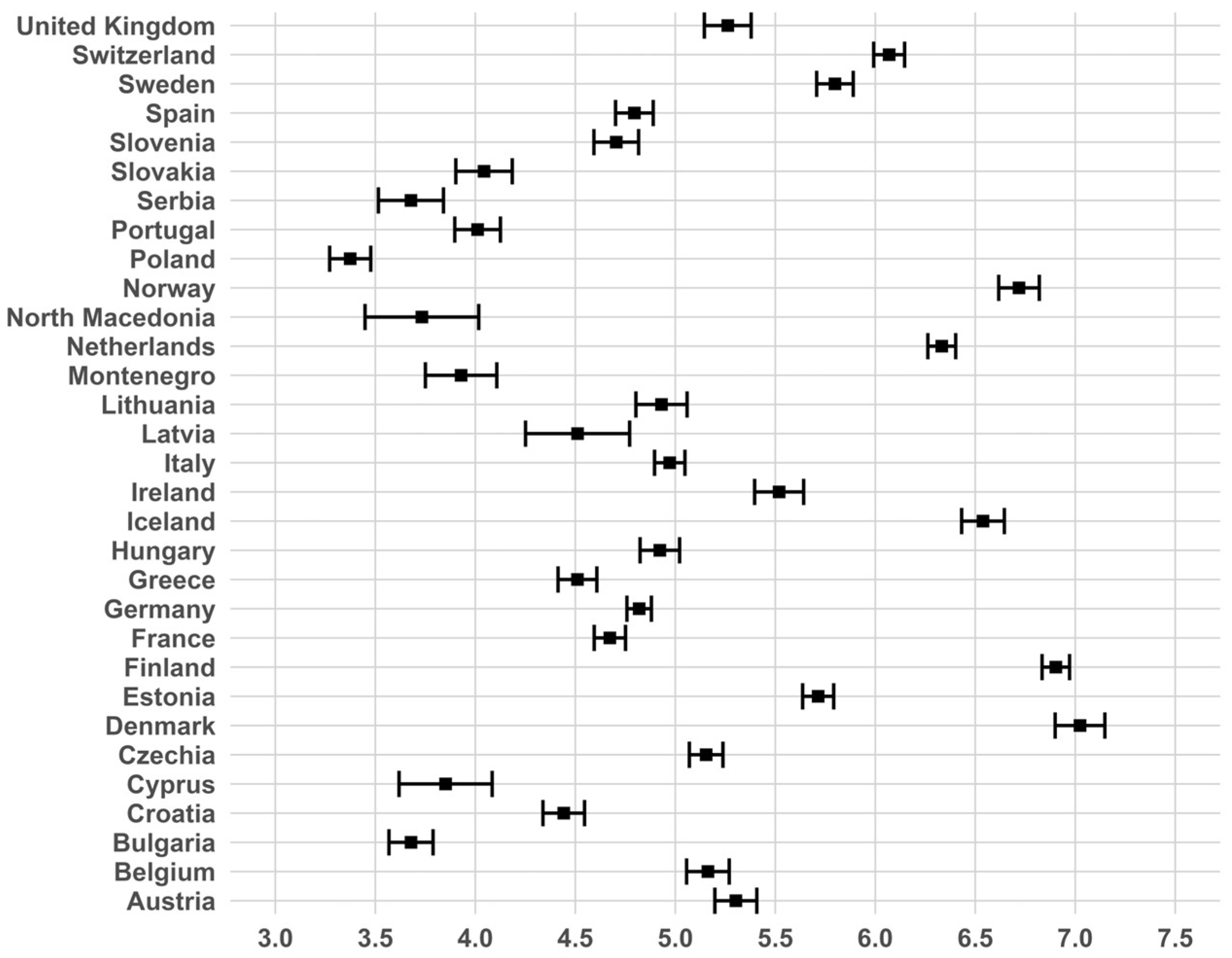
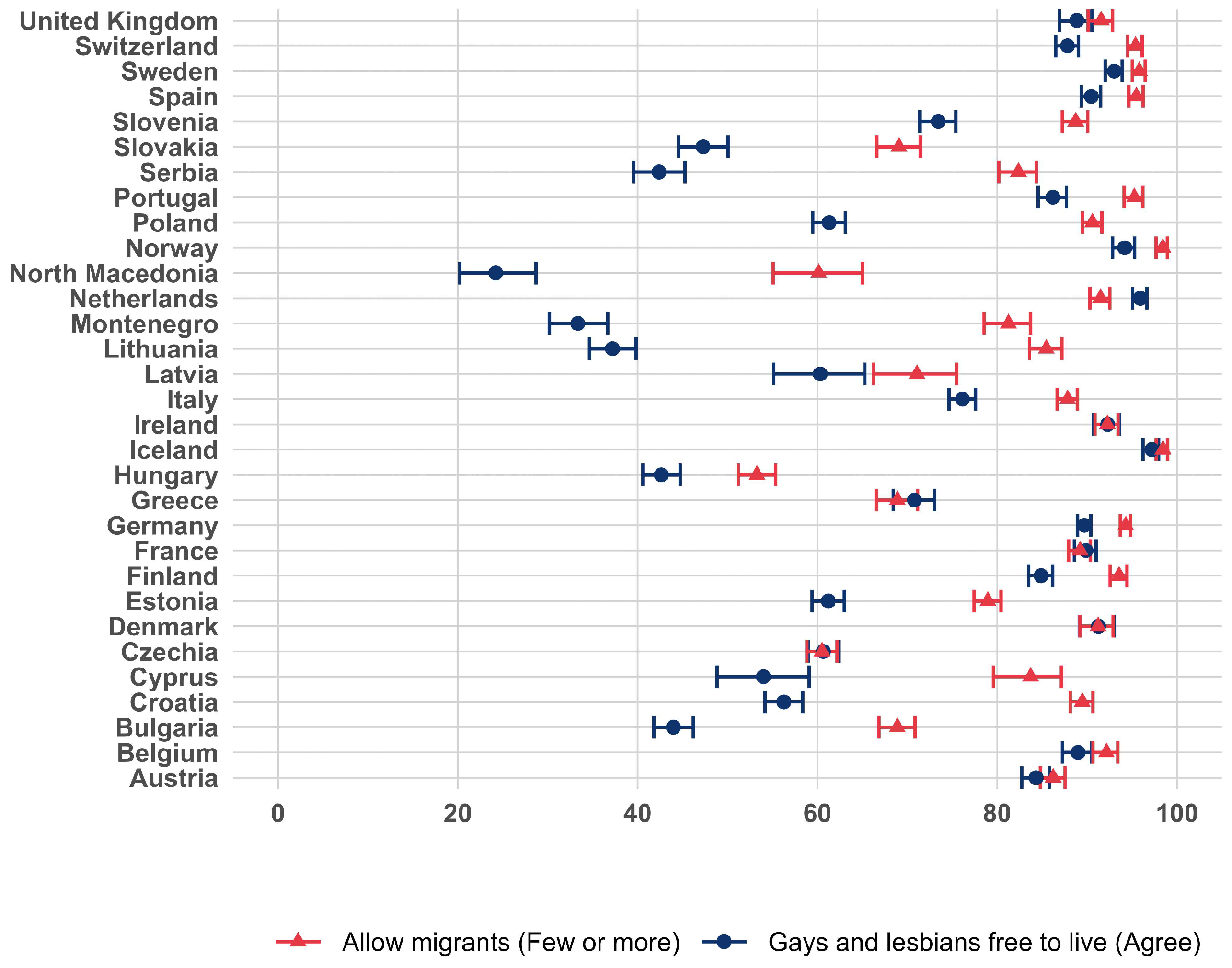
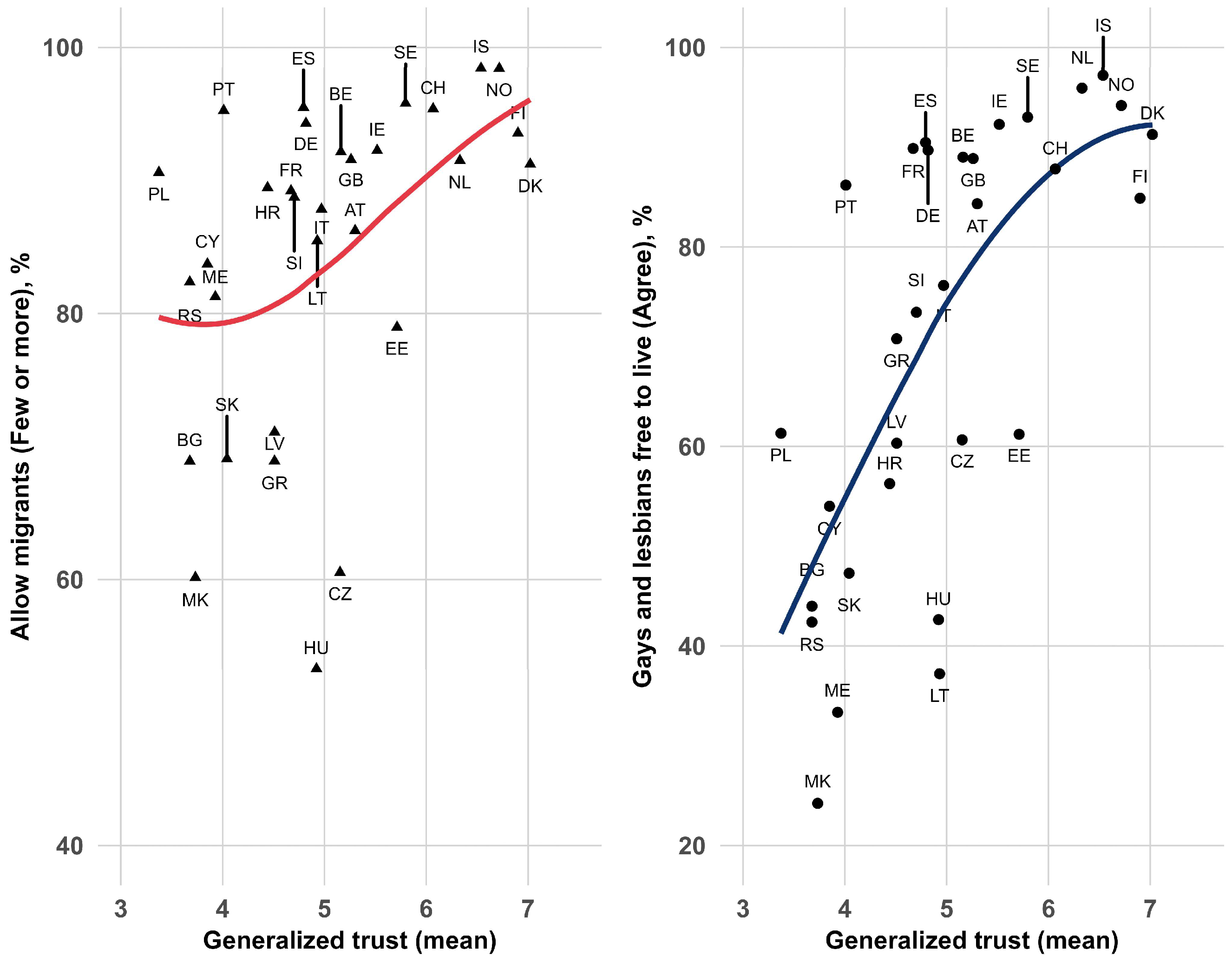
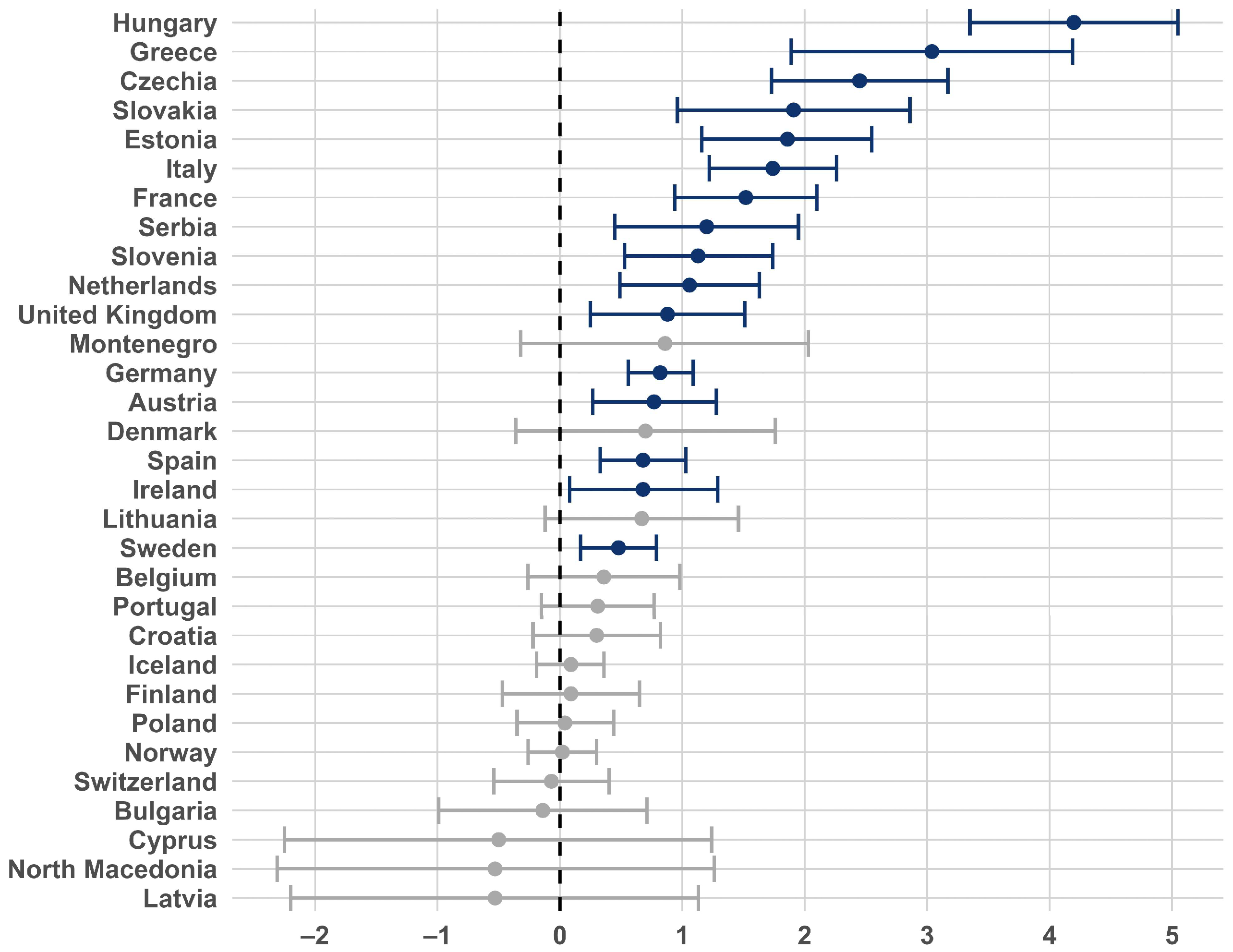
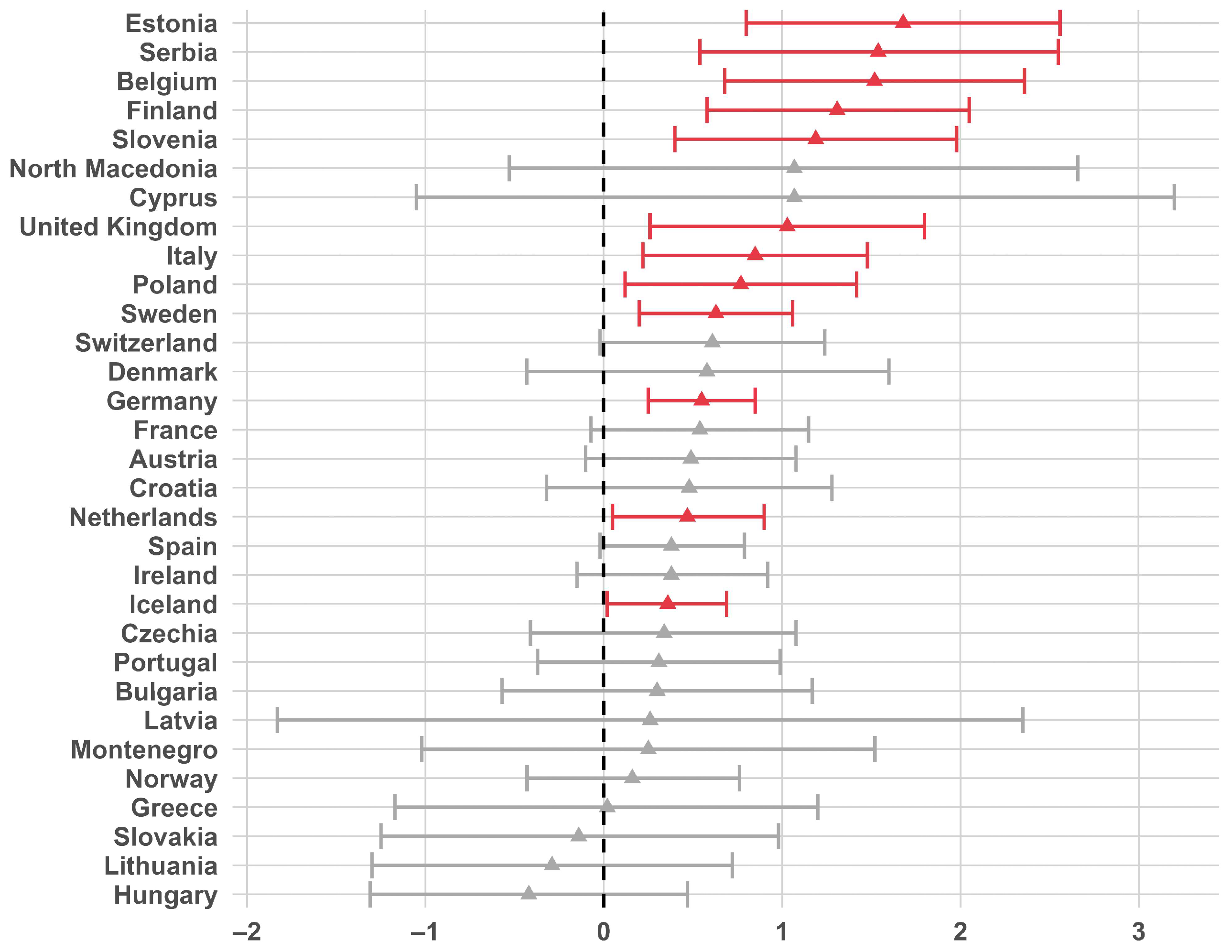
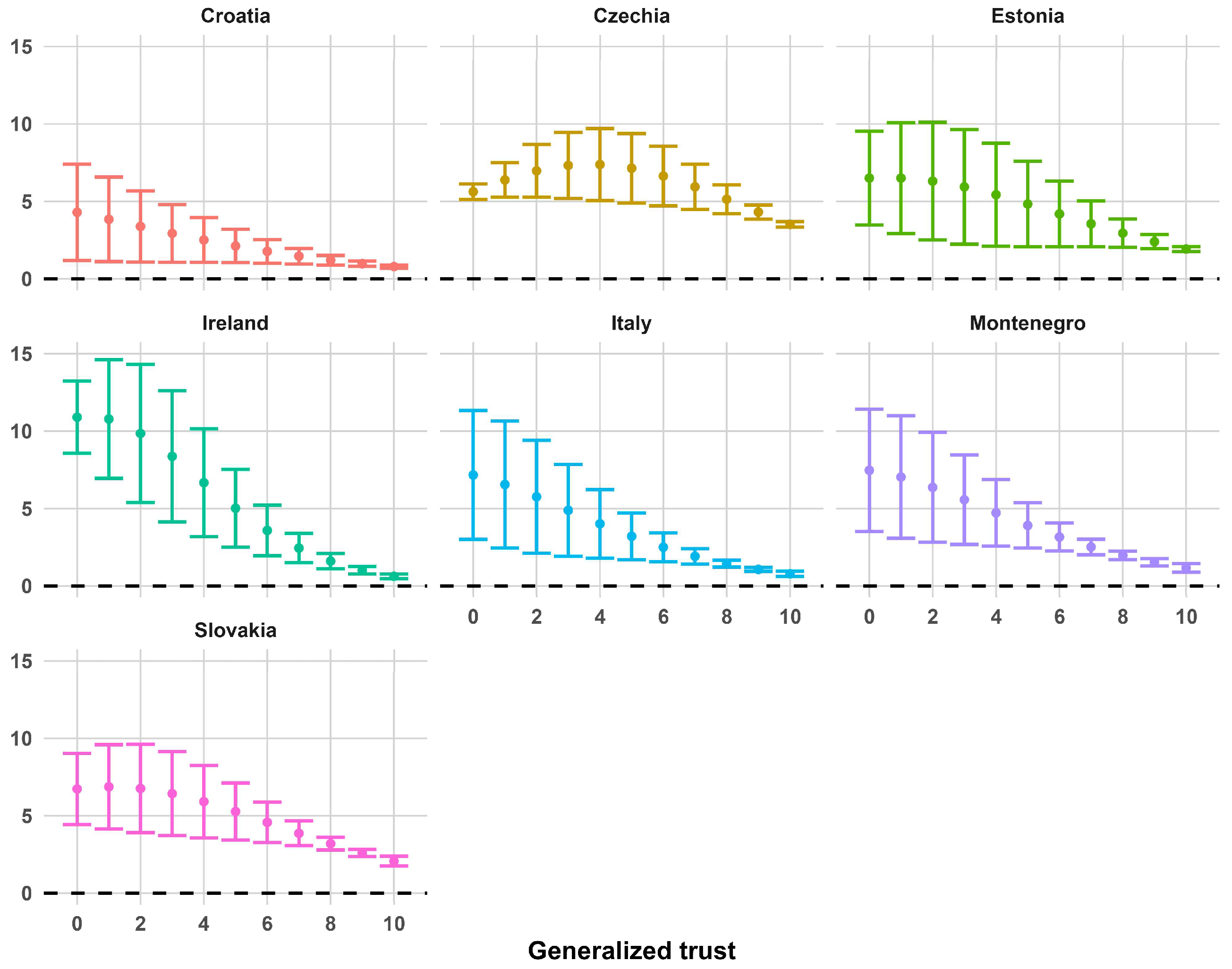
Disclaimer/Publisher’s Note: The statements, opinions and data contained in all publications are solely those of the individual author(s) and contributor(s) and not of MDPI and/or the editor(s). MDPI and/or the editor(s) disclaim responsibility for any injury to people or property resulting from any ideas, methods, instructions or products referred to in the content. |
© 2023 by the authors. Licensee MDPI, Basel, Switzerland. This article is an open access article distributed under the terms and conditions of the Creative Commons Attribution (CC BY) license (https://creativecommons.org/licenses/by/4.0/).
Share and Cite
Bodor, Á.; Grünhut, Z.; Erát, D.; Hegedüs, M. Reconsidering the Empirical Measurement of Trust towards Unknown Others. Soc. Sci. 2023, 12, 583. https://doi.org/10.3390/socsci12100583
Bodor Á, Grünhut Z, Erát D, Hegedüs M. Reconsidering the Empirical Measurement of Trust towards Unknown Others. Social Sciences. 2023; 12(10):583. https://doi.org/10.3390/socsci12100583
Chicago/Turabian StyleBodor, Ákos, Zoltán Grünhut, Dávid Erát, and Márk Hegedüs. 2023. "Reconsidering the Empirical Measurement of Trust towards Unknown Others" Social Sciences 12, no. 10: 583. https://doi.org/10.3390/socsci12100583
APA StyleBodor, Á., Grünhut, Z., Erát, D., & Hegedüs, M. (2023). Reconsidering the Empirical Measurement of Trust towards Unknown Others. Social Sciences, 12(10), 583. https://doi.org/10.3390/socsci12100583







